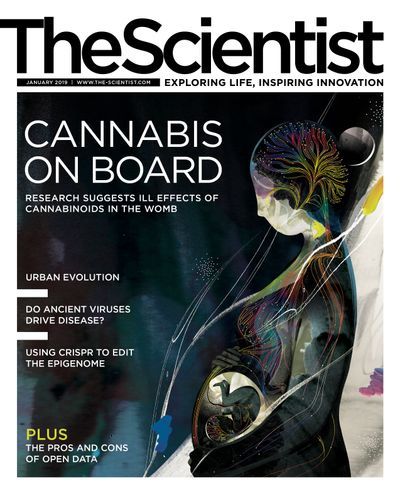Login
SubscribeFeatures

Can Viruses in the Genome Cause Disease?
Katarina Zimmer | Jan 1, 2019 | 10+ min read
Clinical trials that target human endogenous retroviruses to treat multiple sclerosis, ALS, and other ailments are underway, but many questions remain about how these sequences may disrupt our biology.

Cities Can Serve as Cauldrons of Evolution
Catherine Offord | Jan 1, 2019 | 10+ min read
From changes in gene flow to adaptation, the effects of urbanization are shaping the evolutionary trajectories of plants and animals.

Prenatal Exposure to Cannabis Affects the Developing Brain
Andrew Scheyer | Jan 1, 2019 | 10+ min read
Children born to moms who smoked or ingested marijuana during pregnancy suffer higher rates of depression, hyperactivity, and inattention.
Contributors
Contributors
Contributors
Meet some of the people featured in the January 2019 issue of The Scientist.
Editorial
Genome Editing on Board
Genome Editing on Board
2018 closed with hubbub surrounding the purported birth of babies whose genomes had been edited using CRISPR. What will 2019 hold for CRISPR’s use in humans?
Speaking of Science
Ten-Minute Sabbatical
Ten-Minute Sabbatical
Take a break from the bench to puzzle and peruse.
Notebook
Researchers Aim to Reestablish an Ancient Fish in an Ohio River
Researchers Aim to Reestablish an Ancient Fish in an Ohio River
The sturgeon restoration study’s outcome won’t be known for decades.
Competition and Cooperation of Cheese Rind Microbes Exposed
Competition and Cooperation of Cheese Rind Microbes Exposed
Transposon mutagenesis give scientists a rare look at the most important interactions within microbial communities.
Researchers Track Sharks and Whales Using DNA in Seawater Samples
Researchers Track Sharks and Whales Using DNA in Seawater Samples
In addition to detecting unseen organisms in the ocean, studies of environmental DNA can shed light on the genetic structure of marine populations.
Researchers Explore the Genetics of Eating Disorders
Researchers Explore the Genetics of Eating Disorders
Large-scale genomic studies of anorexia and bulimia are turning up clues about the conditions’ development and persistence.
Modus Operandi
Taming the Transposon Hordes
Taming the Transposon Hordes
Researchers repurpose the CRISPR machinery to turn whole classes of transposable elements on or off.
The Literature
Mitochondria Play an Unexpected Role in Killing Bacteria
Mitochondria Play an Unexpected Role in Killing Bacteria
The energy-producing organelles also send out parcels with antimicrobial compounds to help destroy pathogen invaders in macrophages.
Frogs Have a Bioelectric Mirror
Frogs Have a Bioelectric Mirror
Amputation of one limb triggers a rapid electric response that reflects the injury in the opposite one, researchers find.
Serotonin Neurons Implicated in SIDS
Serotonin Neurons Implicated in SIDS
Inhibiting nerve cells that produce the neurotransmitter made it harder for baby mice to recover from bouts of slowed breathing.
Profile
T-cell Tracker: A Profile of Wendy Havran
T-cell Tracker: A Profile of Wendy Havran
By uncovering novel properties of a unique population of T cells, the Scripps Research Institute immunologist has helped to redefine the immune cells, uncovering their role in wound healing.
Scientist to Watch
Jorge Henao-Mejia Explores the Immune System’s Controls
Jorge Henao-Mejia Explores the Immune System’s Controls
By tying together his understanding of the microbiome and nucleic acids, the UPenn immunologist is decoding the underlying causes of inflammation and disease.
Lab Tools
Researchers Engineer Epigenome Editors to Study How Gene Expression Affects Disease
Researchers Engineer Epigenome Editors to Study How Gene Expression Affects Disease
Using CRISPR and other tools, scientists are modifying DNA methylation, histone marks, and other modifiers of gene expression to understand how they affect health and disease.
Careers
The Open Data Explosion
The Open Data Explosion
Scientists are working to maximize the benefits and minimize the costs of sharing.
Reading Frames
The “Science” of Hangovers
The “Science” of Hangovers
As advanced as humans are, we still don’t have a handle on how to tame our response to a night of drinking.
Foundations
Painting Dinosaurs, early 20th century
Painting Dinosaurs, early 20th century
Charles R. Knight’s illustrations shaped the public’s view of prehistoric life.
Infographics
Infographic: How Exposure to Cannabis in Utero Affects Development
Infographic: How Exposure to Cannabis in Utero Affects Development
Rodent and human studies have revealed a multitude of effects starting during gestation and lasting into adulthood.
Infographic: How Cities Influence Evolution
Infographic: How Cities Influence Evolution
Urban environments are driving genetic changes in resident species through multiple mechanisms, from establishing gene flow barriers to exerting novel selection pressures.
Infographic: Controlling Transposons En Masse
Infographic: Controlling Transposons En Masse
Researchers repurpose the CRISPR machinery to
turn whole classes of transposable elements on or off.
Infographic: Human Endogenous Retroviruses and Disease
Infographic: Human Endogenous Retroviruses and Disease
Human endogenous retroviruses that colonized vertebrate DNA millions of years ago have long been dismissed as junk DNA, but researchers now know that they may play important roles in cancer, neurodegeneration, and other ailments.
Infographic: How Macrophage Mitochondria Help Destroy Pathogens
Infographic: How Macrophage Mitochondria Help Destroy Pathogens
Researchers have uncovered a mechanism whereby macrophages employ
their energy-generating organelles to aid in bacterial killing.






















